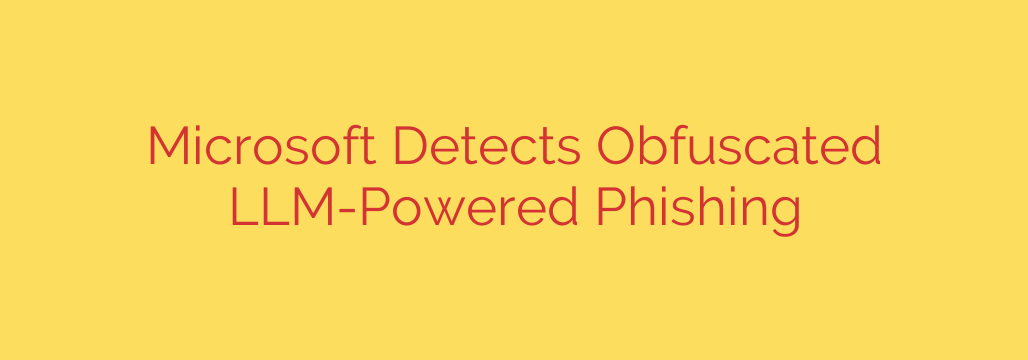
The Next Wave of Phishing: How AI Is Hiding Malicious Attacks in Plain Sight
For years, cybersecurity experts have warned that artificial intelligence would eventually be used to create more convincing and dangerous phishing emails. That future is now here, but not in the way most people expected. Threat actors are now leveraging Large Language Models (LLMs)—the same technology behind popular AI chatbots—to create phishing attacks that are incredibly difficult to detect.
This new technique goes far beyond simply writing a more grammatically correct email. Instead, attackers are using AI to generate and deliver the fake login pages in real-time, a method that cleverly bypasses many traditional security filters.
The New Phishing Playbook: An On-the-Fly Deception
In a typical phishing attack, a cybercriminal builds a fake login page, hosts it on a server, and includes a link to it in a phishing email. Security software can often detect these attacks by scanning the email for malicious links or by analyzing the destination page to see if it’s a known phishing site.
This new, AI-powered method is far more sophisticated. Here’s a breakdown of how it works:
- The Lure: The attack begins with a seemingly standard email about an invoice, a secure document, or another common business topic. Instead of a link, the email contains a simple HTML file as an attachment.
- The Hidden Code: This HTML attachment appears harmless to most email security scanners. However, it contains heavily obfuscated JavaScript code, which is essentially a set of hidden instructions that run when the file is opened in a web browser.
- The AI Call: The hidden code’s primary job is to make an API call to a legitimate LLM service. It sends a specific prompt to the AI, instructing it to generate the HTML code for a well-known login page, such as one for Microsoft 365 or DocuSign.
- The Live Impersonation: The AI model, simply following instructions, generates the code for a convincing login page. This code is then injected directly into the user’s browser, creating the fake page on the spot. Since the malicious content never existed on a server and wasn’t present in the initial email, it evades detection.
The user sees a perfect replica of a familiar login screen and is tricked into entering their username and password, which are then sent directly to the attacker.
Why This AI-Powered Technique Is So Dangerous
This method represents a significant evolution in phishing attacks because it effectively neutralizes many common defense mechanisms.
- Evades Traditional Security Scanners: Because the initial email attachment contains no obvious malicious links or code, it often gets a clean bill of health from email gateways. The attack’s payload is generated dynamically and locally, leaving no trail for scanners to follow.
- Highly Scalable and Adaptable: Attackers don’t need to build and host dozens of fake websites. They can switch their target from one service to another simply by changing the prompt they send to the AI. This allows them to launch diverse and widespread campaigns with minimal effort.
- Bypasses Blocklists: Security tools often rely on lists of known malicious domains to block phishing sites. With this technique, there is no malicious domain to block. The entire phishing page exists only within the victim’s browser for a brief moment.
How to Protect Yourself and Your Organization
As threat actors adopt more advanced tools, our defenses must also evolve. While this technique is sophisticated, you can still protect yourself by adhering to fundamental cybersecurity principles.
- Treat HTML Attachments with Extreme Caution: There are very few legitimate reasons for a business to send an invoice or document as an HTML file. Consider any unexpected .html or .htm attachment a major red flag. Instruct users not to open them unless they have been explicitly verified through a separate communication channel.
- Enable and Enforce Multi-Factor Authentication (MFA): This remains the single most effective defense against credential theft. Even if an attacker successfully steals a user’s password, MFA prevents them from accessing the account without the second verification factor (like a code from an app or a text message).
- Foster a Culture of Healthy Skepticism: Educate your team to scrutinize every email. Ask critical questions: Was I expecting this email? Does the sender’s address look correct? Is the request unusual or creating a false sense of urgency? The human firewall is more important than ever.
- Implement Advanced Threat Protection: Ensure your organization’s email security solution is capable of more than just static analysis. Look for tools that can perform sandbox analysis on attachments to observe their behavior in a safe environment.
The weaponization of AI by cybercriminals marks a new chapter in digital security. By understanding these emerging threats and reinforcing our defenses, we can stay one step ahead of those who seek to exploit them.
Source: https://www.helpnetsecurity.com/2025/09/25/microsoft-spots-llm-obfuscated-phishing-attack/








